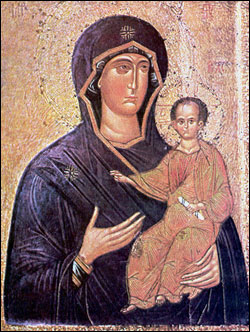|
Smolensk icon of the Mother of God
On August 10th (June 28th by the old calendar) the Church celebrates the feast of the Smolensk icon of the Mother of God.
The miraculous image of the Theotokos that was named the Smolensk icon, was brought to Russia in 1046 by the Greek princess Anna. The icon was a parental blessing to her from her father, Emperor Constantine Monomachus of Byzantium, for her marriage to Prince Vsevolod Yaroslavovich of Chernigov.
In 1101 the son of Princess Anna, Prince Vladimir Monomachus, transferred the wonderworking icon from Chernigov to Smolensk. Here lay the most convenient way for invaders to pass into the interior of the land, and the Mother of God became the protectress of Russian borders.
In 1238 hordes of Tatars gathered for a new attack on Russia near the city of Smolensk. The destruction of the city seemed inevitable. The inhabitants’ sole hope lay in God’s mercy, and they prayed before the icons in the hope of a miracle. Then the pious sacristan of the church of Dormition had a vision during the night from the Smolensk icon: a voice commanded him to bring the soldier Mercurius into the church in full military attire. Obeying the wondrous command, Mercurius came into the church and saw the Most-holy Theotokos sitting on a golden throne with the Infant Christ, surrounded by a host of angels. Mercurius fell on his knees before Her and bowed to Her with great trepidation and awe. The Queen of Heaven raised him up and commanded him to use his sword against Christ’s enemies, while in order to defeat them spiritually, Mercurius was to atone for his compatriots’ sin by his voluntary death. Mercurius began sorrowing and shedding tears, but then, submitting to God’s will, he was strengthened in spirit, jumped up on his horse and fulfilled the Theotokos’ command. Tearing into the enemy camp, he slew innumerable Tatars and forced khan Batyy himself to flee. The great khan left the Russian land with only a small band of warriors, and was later slain by the Hungarian King Stephen.
|

Smolensk icon of the Mother of God
|
Up to the 15th century the Theotokos guarded Smolensk from foreign invasions. At the threshold of the new century the icon turned up in Moscow. At that time, in the middle of the century, all the Orthodox churches that were under the Polish and Lithuanian crowns were forced to submit to the Pope. It was difficult for Russian people to live under the domination of foreigners, but the spiritual yoke was even heavier. In 1456, Bishop Misael of Smolenk, accompanied by emissaries from the city, went to Moscow for a miraculous helper – the Smolenk icon of the Mother of God. The Grand Duke Basil the Blind and the holy Metropolitan Jonah agreed to let the icon go, but first they ordered a copy to be made, which was set in its place in the cathedral. Afterwards for another half-a-century the Theotokos defended Her home from the affliction of Lithuanian heresy, and finally the city of Smolensk, having stood fast in Orthodoxy and having refused to bow down to the Uniates, was returned to Russia.
|
|
A hundred years later, during the Time of Troubles, Smolensk was once again occupied by the Poles. Its liberation took place in 1667, when by the efforts of Bishop Barsonuphius of Smolensk the wonderworking icon, darkened by the passage of time, was cleaned and restored.
In 1812, during the war with Napoleon, the icon was hastily evacuated to Moscow, while the great army of Napoleon moved along the road from Smolensk to the heart of Russia. In Moscow the Smolensk icon, together with the Vladimir and the Iveron icons, was carried in a procession around the Kremlin walls. Along the entire way the inhabitants met the miraculous icons of the Mother of God on their knees, tearfully praying for the salvation of the homeland. The Smolensk and the Iveron icons were also taken to the hospitals to visit the wounded. On the eve of the Russian army’s retreat from Moscow, the Smolensk icon was moved to Yaroslavl, where it remained until the end of the war. Now the ancient sacred icon is kept in the Smolensk Cathedral and is worshipped as a never-ceasing source of grace and as a guide (Odigitria in Greek) showing the way to salvation. In the iconography of the Odigitria, created by the apostle and evangelist Luke, the Theotokos is shown to Her waist, standing straight with the Infant Christ on Her left arm and pointing at Him with Her right. The Mother of God forms a sort of throne on which Her son sits in the image of God Almighty: in one hand He holds a scroll – symbol of the Universe, and with the other He blesses His creation. In this icon the Theotokos points us all towards the Lord as the only way to salvation, and at the same time the gesture of Her hand is prayerful. She is an intercessor before God for the whole world, and She has been granted special power, for in Her hands She holds the uncontainable God, Master of heaven and earth!
|
|
|